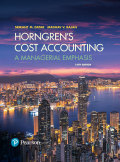
Concept explainers
Target costs, effect of product-design changes on product costs. Neuro Instruments uses a manufacturing costing system with one direct-cost category (direct materials) and three indirect-cost categories:
- a. Setup, production-order, and materials-handling costs that vary with the number of batches
- b. Manufacturing-operations costs that vary with machine-hours
- c. Costs of engineering changes that vary with the number of engineering changes made
In response to competitive pressures at the end of 2016, Neuro Instruments used value-engineering techniques to reduce
| 2016 | 2017 | |
| Setup, production-order, and materials-handling costs per batch | $ 8,900 | $8,000 |
| Total manufacturing-operations cost per machine-hour | $ 64 | $ 48 |
| Cost per engineering change | $16,000 | $8,000 |
The management of Neuro Instruments wants to evaluate whether value engineering has succeeded in reducing the target manufacturing cost per unit of one of its products, HJ6, by 5%.
Actual results for 2016 and 2017 for HJ6 are:
| Actual Results for 2016 | Actual Results for 2017 | |
| Units of HJ6 produced | 2,700 | 4,600 |
| Direct material cost per unit of HJ6 | $ 1,400 | $ 1,300 |
| Total number of batches required to produce HJ6 | 60 | 70 |
| Total machine-hours required to produce HJ6 | 20,000 | 30,000 |
| Number of engineering changes made | 24 | 7 |
- 1. Calculate the manufacturing cost per unit of HJ6 in 2016.
Required
- 2. Calculate the manufacturing cost per unit of HJ6 in 2017.
- 3. Did Neuro Instruments achieve the target manufacturing cost per unit for HJ6 in 2017? Explain.
- 4. Explain how Neuro Instruments reduced the manufacturing cost per unit of HJ6 in 2017.
- 5. What challenges might managers at Neuro Instruments encounter in achieving the target cost? How might they overcome these challenges?
Learn your wayIncludes step-by-step video

Chapter 13 Solutions
EBK HORNGREN'S COST ACCOUNTING
Additional Business Textbook Solutions
Financial Accounting, Student Value Edition (5th Edition)
Macroeconomics
Operations Management
Corporate Finance (4th Edition) (Pearson Series in Finance) - Standalone book
Intermediate Accounting (2nd Edition)
MARKETING:REAL PEOPLE,REAL CHOICES
 Principles of Cost AccountingAccountingISBN:9781305087408Author:Edward J. Vanderbeck, Maria R. MitchellPublisher:Cengage Learning
Principles of Cost AccountingAccountingISBN:9781305087408Author:Edward J. Vanderbeck, Maria R. MitchellPublisher:Cengage Learning Essentials of Business Analytics (MindTap Course ...StatisticsISBN:9781305627734Author:Jeffrey D. Camm, James J. Cochran, Michael J. Fry, Jeffrey W. Ohlmann, David R. AndersonPublisher:Cengage Learning
Essentials of Business Analytics (MindTap Course ...StatisticsISBN:9781305627734Author:Jeffrey D. Camm, James J. Cochran, Michael J. Fry, Jeffrey W. Ohlmann, David R. AndersonPublisher:Cengage Learning Cornerstones of Cost Management (Cornerstones Ser...AccountingISBN:9781305970663Author:Don R. Hansen, Maryanne M. MowenPublisher:Cengage Learning
Cornerstones of Cost Management (Cornerstones Ser...AccountingISBN:9781305970663Author:Don R. Hansen, Maryanne M. MowenPublisher:Cengage Learning- Principles of Accounting Volume 2AccountingISBN:9781947172609Author:OpenStaxPublisher:OpenStax College
 Managerial Accounting: The Cornerstone of Busines...AccountingISBN:9781337115773Author:Maryanne M. Mowen, Don R. Hansen, Dan L. HeitgerPublisher:Cengage Learning
Managerial Accounting: The Cornerstone of Busines...AccountingISBN:9781337115773Author:Maryanne M. Mowen, Don R. Hansen, Dan L. HeitgerPublisher:Cengage Learning




